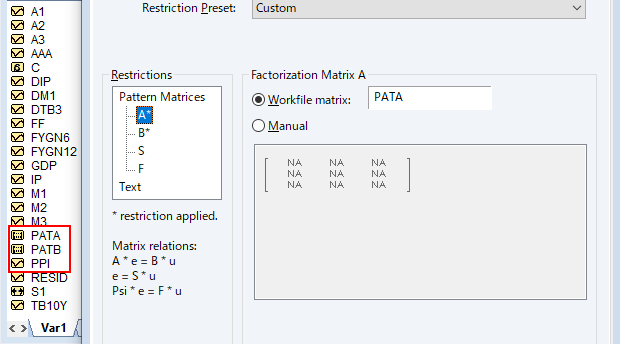
#Svar eviews 10 software#
The result is a state-of-the art program that offers unprecedented power within a flexible, easy-to-use interface.įind out for yourself why EViews is the worldwide leader in Windows-based econometric software and the choice of those who demand the very best. With EViews, you can quickly and efficiently manage your data, perform econometric and statistical analysis, generate forecasts or model simulations, and produce high quality graphs and tables for publication or inclusion in other applications.įeaturing an innovative graphical object-oriented user-interface and a sophisticated analysis engine, EViews blends the best of modern software technology with the features you’ve always wanted. The Granger test indicates the causal associations between the variables and shows the direction of causality based on interaction of current and past values of a pair of variables in the VAR system.A combination of power and ease-of-use make EViews the ideal package for anyone working with time series, cross-section, or longitudinal data. The variables may be related but there may exist no causal relationships between them, or the effect may be bilateral. The IRFs are used to graphically represents the results of a VAR model and project the effects of variables on one another.
#Svar eviews 10 serial#
Next, the model is tested for serial correlation using the Breusch-Godfrey test, for heteroscedasticity using the Breusch-Pagan test and for stability.
#Svar eviews 10 series#
VECM is applied to non-transformed non-stationary series whereas VAR is run with transformed or stationary inputs.Ī VAR model is run with the chosen number of lags and coefficients with standard errors and respective t-statistics are calculated to assess the statistical significance. If the variables are cointegrated, VECM is applied in the following analysis instead of a VAR model. The Johansen cointegration test is conducted to check whether the variables integrated of the same order share a common integrating vector(s). In this case, they can be analysed with a Vector Error Correction Model (VECM) instead of VAR. The variables may be non-stationary but integrated of the same order. If a variable is non-stationary, the first difference should be taken and tested for stationarity in the same way. A widely used method for estimating stationarity is the Augmented Dickey-Fuller test and the Phillips-Perron test. The next step is estimating stationarity of the variables. The most commonly used ones are the Akaike IC, Hannah-Quinn criterion and Schwarz criterion. Information criteria (IC) are employed to determine the optimal lag length. Each equation has its own dependent variable while the explanatory variables are the lagged values of this variable and other variables.Įstimation of a VAR model includes the following steps: In fact, a VAR model consists of k OLS regression equations where k is the number of employed variables. This allows for estimating not only the instantaneous effects but also dynamic effects in the relationships up to n lags. So, a specific trait of this model is that it includes lagged values of the employed variables as regressors.

This is an atheoretical model meaning that the choice of variables does not have to be backed by any specific theory and the relationship is determined based on the effects of previous changes in one variable on current changes in the other variable along with the effects of past changes of the variable on its own current changes. A vector autoregression model (VAR) is a model often used in statistical analysis, which explores interrelationships between several variables that are all treated as endogenous.


 0 kommentar(er)
0 kommentar(er)
